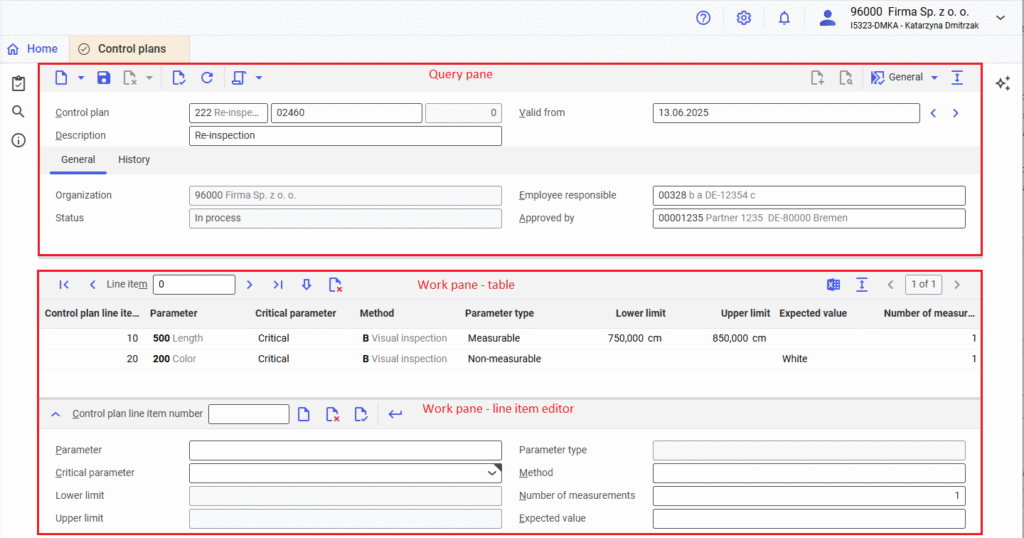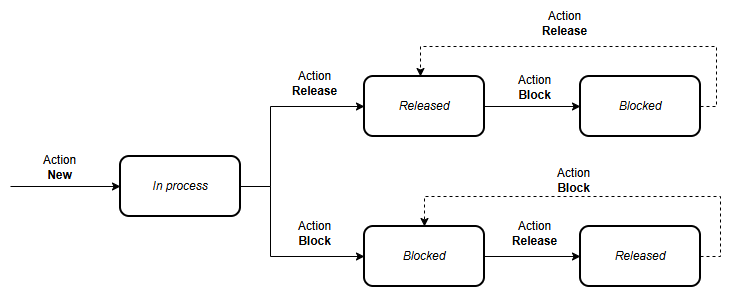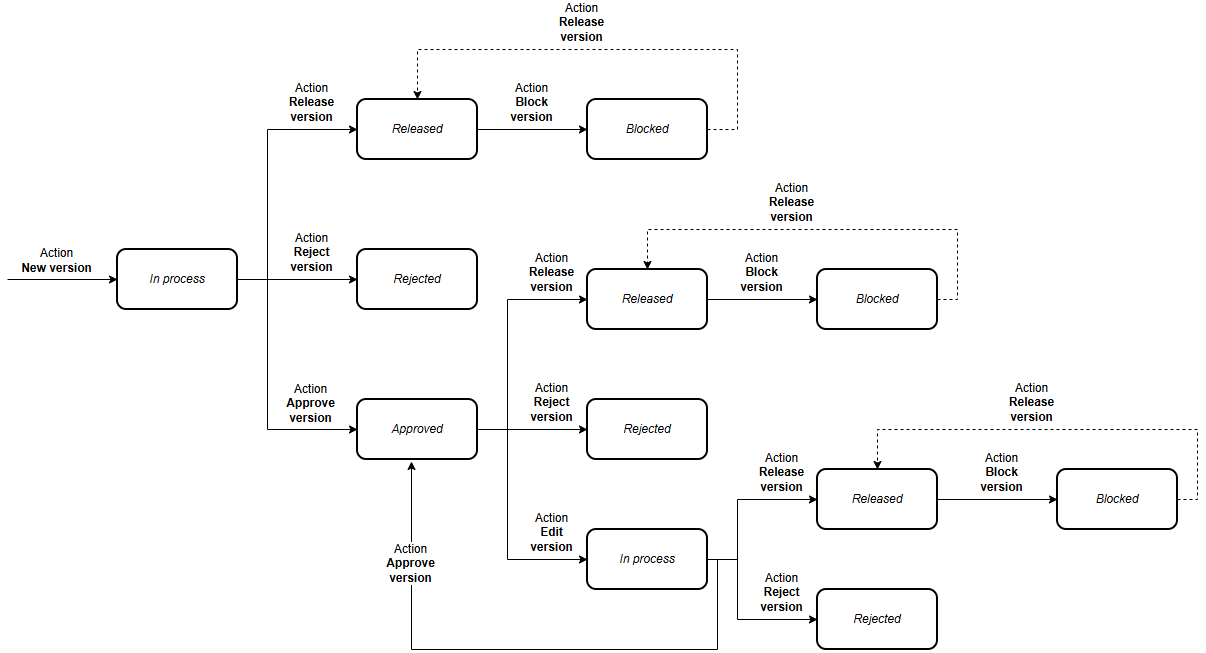Application description
A control plan is a document that organizes an organization’s quality management for its product or processes. It contains a list of parameters and their acceptable control methods. It also specifies the criticality level and tolerance range of the parameters, as well as responsible persons. The Control plans application is used to create a control plan. Control plans are created based on the types of control plans containing default data. This article provides a thorough description of the Control plans application.
An inspection plan created in the application can apply to one sample only. The size of the sample can be specified when creating an inspection order. The number of measurements indicates how many times the sample should be measured. Control plans can be versioned in the application.
Line items created in the Control plans application are only visible to the organization that created them.
Users can access the Control plans application when the Quality Management function is activated in the Customizing application.
A user must additionally be assigned to an inventory management organization in order to use this application.
The Control plans application consists of:
- Query pane – contains the standard button bar and tabs:
- General
- History
- Work pane divided into:
- Line item table – displays data according to the filter defined in the application query pane. In the table, you can also enter new objects
- Line item editor – used to edit specific line items from the table

Query pane
In the query pane of the Control plans application, you can create a new and search for an existing control plan.

The query panel contains the following action buttons:
[New] → [New] – adds a new control plan to the system
[New] → [New version] – adds a new version of the control plan to the system
[New] → [Duplicate] – duplicates a control plan. The button becomes active when you open a control plan that was previously created and saved.
[Save] – verifies the entered parameters for data correctness (just like the [Verify] button). If the verification is successful, it saves the changes to the document. If the data is incorrect, the fields are marked with red flags and the control plan is not saved.
[Delete] – insensitive button. Data are deleted in the Reorganization of quality management master data application after they are first marked for deletion.
[Mark for deletion] – marks the selected control plan for deletion
[Unmark for deletion] – removes the deletion marker from the control plan
[Validate] – checks the entered control plan data for correctness and whether all mandatory fields have been completed. If data are missing or incorrect, the field is flagged with a red triangle in the corner.
[Refresh] – restores the application to its previously saved version
[Select action]
[Release] – releases the control plan. You must release the control plan if you want to use it in subsequent quality management steps. When you select this action, the control plan status changes to Released and the control plan can be used in the quality management process.
[Block] – blocks the control plan. You can block a control plan if you want to discard changes to a document or prevent its use in other applications. When you select this action, the control plan status changes to Blocked. A blocked control plan cannot be used in the quality management process.


[Edit Version] – edits the control plan. When you select this action, the control plan status changes automatically to In process. Once this option is selected, the control plan can be released or approved in subsequent steps.
[Approve version] – approves the control plan in its current configuration. This is the initial approval of the control plan. When you select this action, the control plan status changes automatically to Under approval. Once this option is selected, the control plan can be released or edited in subsequent steps.
[Reject version] – rejects the control plan. You can reject the control plan if you want to discard changes to the document or prevent its use in other applications. The action is irreversible. When you select this action, the control plan status changes to Rejected, meaning the control plan can no longer be used in the quality management process and the action buttons are deactivated.
[Release version] – releases a control plan. You must release the control plan if you want to use it in subsequent quality management steps. When you select this action, the control plan status changes to Released. Once released, the control plan can be used in the quality management process.
[Block version] – blocks a control plan. You can block a control plan if you want to discard changes to the document or prevent its use in other applications. When you select this action, the control plan status changes to Blocked. Once blocked, the control plan cannot be used in the quality management process.
The query pane by default consists of the following identification fields:
Control plan – enter the identification of the control plan in this field. This three-segment field constitutes the full name of the control plan when combined:
- Type – the field contains the type of control plan, which can be defined in the Control plan types application.
- Code – the field contains the name of the control plan. It can consist of up to 25 characters (numbers, letters or a combination of both).
- Version – the field contains the document’s version number. This number is assigned automatically for each successive version of the document. The validity period of each version differs. Data in this field is only displayed when versioning is enabled in the Customizing application. This field will be empty if versioning is not enabled.
Valid from – the date from which the control plan is valid. This is a date format field. The current date is set by default.
Description – a short description of the control plan. It serves as an additional distinguishing characteristic. It can consist of any user-defined text. Enter a meaningful description that is as unique as possible to facilitate searches for it.
General tab

Organization – the organization for which the control plan is created. The field is automatically filled in based on the organization that the user is currently logged into (this setting is found on the main menu bar of the application).
Employee responsible – the person responsible for the control plan. The field can be filled in with the name of the system user. The employee must be assigned to the organization. The system checks whether the current user creating the document is listed as an employee in the Partners application.
Status – status of the control plan. This field is automatically filled in with one of the following statuses:
- Released – this status is visible when you select the [Release version] action
- In process – this status is visible when creating and editing the control plan, until it is released, rejected or blocked
- Blocked – this status is visible when you select the [Block version] action
- Under approval – this status is visible when you select the [Approve version] action
- Rejected – this status is visible when you select the [Reject version] action
- Expired – this status is visible when a new version of the control plan is created and released. Only a control plan with a Released status can be used in the Inspection orders application.
Approved by – the person designated to approve the control plan. Only the approver should be able to release or block the control plan.
History tab
The History tab contains a line item table shows the history of changes to document status. The fields in the table are informational only. They displa data on changes made, but are not intended for editing.

Each document change is presented in a separate row with the following columns:
Point in time – the exact moment (date and time) when the document’s status changed
Employee – the employee who changed the document status
Status – the assigned to the document
Work pane – table
In the work pane, you can create new and edit existing control plan line items. The work pane consists of a table and a line item editor. The table shows the sequentially numbered line items of the control plan.

The table contains the following buttons and fields:
Line item – the ordinal number of the selected line item in the table.
[Edit] – displays line item details in the line item editor.
[Delete] – removes the parameter line item from the control plan. The line item is deleted upon selecting the [Save] action.
[Output pages already displayed into file] – outputs data from the table into a file. The file is output in XLS format.
[Show/hide title bar] – shows/hides the table header.
Control plan line item number – line item number of the control plan. It is assigned automatically
Parameter – this column shows the parameter subject to quality management.
Critical parameter – this column shows the importance of the parameter. The following options are available for selection:
- Critical
- Non-critical
Method – this column shows how quality management is carried out.
Parameter type – this column informs whether the parameter is measurable or non-measurable. The field is automatically filled in with data from the Parameter type field in the Parameters application. The following parameter types can be displayed in this field:
- Measurable
- Non-measurable
Lower limit – this column shows the lower acceptable value of the parameter if the parameter type is measurable. This is a numeric field with a unit that is automatically assigned and selected in the Parameters application. This is the lower limit of the measurement tolerance.
Upper limit – this column shows the upper acceptable value of the parameter if the parameter type is measurable. This is a numeric field with a unit that is automatically assigned and selected in the Parameters application. This is the upper limit of the measurement tolerance.
Expected value – this column shows the expected value of the parameter if the selected parameter type is non-measurable.
Number of measurements – this column shows how many times one sample of the parameter must be measured.
Work pane – line item editor
The line item editor contains details of the line items in the table. In the table, you can mainly enter new line items and edit them.

The bar contains the following fields and buttons:
Line item – the ordinal number of the selected item in the table
[New line item of selected category] – adds a new control plan line item
[Delete] – deleted a line item
[Validate] – verifies the data entered into the line item editor for correctness
[Accept current line item] – accepts the line item into the table
Parameter – a parameter subject to quality management. Any existing parameter, previously created in the Parameters application, can be entered in the field. The parameter identification is unique within the OLTP database.
Parameter type – this field is automatically filled in with data from the Parameter type field in the Parameters application. The field informs whether the parameter is measurable or non-measurable. The following parameter types can be displayed in the field:
- Measurable
- Non-measurable
Critical parameter – in this field, specify the importance of the parameter. This information field can help users decide whether to accept or reject an item after quality management. Selectable options are:
- Critical
- Non-critical
Method – this field shows how quality management is carried out. In this field, you can enter any existing method previously created in the Methods application.
Lower limit – enter the lower acceptable value of the measurable parameter in this field. This is a numeric field with a unit that is automatically assigned and selected in the Parameters application. This is the lower limit of the measurement tolerance.
Upper limit – enter the upper acceptable value of the measurable parameter in this field. This is a numeric field with a unit that is automatically assigned and selected in the Parameters application. This is the upper limit of the measurement tolerance.
Expected value – the field contains the feature that is the expected result of the quality management, such as a white matte finish.
Number of measurements – this field shows how many times one sample of the parameter must be measured.
Customizing
The Control Plans application can only be used if the Quality Management function is activated for organizations in the Customizing application.
Business entities
The following business entity is relevant for the Control plans application that you use, for example, to:
- create a control plan
Control plan: com.sem.ext.app.qm.obj.QualityControlPlan
This unit is part of the business entity group com.sem.ext.app.qm.MasterData
Authorizations
Authorizations can be assigned by means of authorization roles as well as by assigning an organization. The authorization concept is described in the technical article Authorizations.
Special capabilities
There are no special capabilities for the Control plans application.
Organization assignments
If the Content-based authorizations parameter is activated in the Customizing application under the Base function, a person can only view the Control plans application if an organization that is linked to at least one of the following structures has been assigned to him or her in the partner master data:
- Inventory management
Special features
There are no special features for the Control plans application.
Authorizations for business partners
The Control plans application is not released for business partners.
